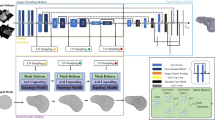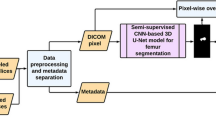Abstract
Three-dimensional (3D) reconstruction of computed tomography (CT) and magnetic resonance imaging (MRI) images is an important diagnostic method, which is helpful for doctors to clearly recognize the 3D shape of the lesion and make the surgical plan. In the study of medical image reconstruction, most researchers use surface rendering or volume rendering method to construct 3D models from image sequences. The watertightness of the algorithm-reconstructed surface will be affected by the segmentation precision or the thickness of the CT layer. The articular surfaces at femoral ends are often used in biomechanical simulation experiments. The model may not conform to its original shape due to the manual repair of non-watertight surfaces. To solve this problem, a 3D reconstruction method of leg bones based on deep learning is proposed in this paper. By deforming the convex hull of the target, comparing with state-of-the-art methods, our method can stably generate a watertight model with higher reconstruction accuracy. In the situation of target transition structures getting fuzzy and the layer spacing increasing, the proposed method can maintain better reconstruction performance and appear higher robustness. Also, the chamfer loss is optimized based on the rotational shape of the leg bones, and the weight of the loss function can be assigned according to the geometric characteristics of the target. Experiment results show that the optimization method improves the accuracy of the model. Furthermore, our research provides a reference for the application of deep learning in medical image reconstruction.
Graphical abstract













Similar content being viewed by others
Explore related subjects
Discover the latest articles and news from researchers in related subjects, suggested using machine learning.References
Fang W, Lin D, Kou W et al (2022) Advances in medical image three-dimensional reconstruction system[J]. Chinese J Med Phys 39(7):823–827
Lu LY, Yin MX, Fu LY et al (2023) Uncertainty-aware pseudo-label and consistency for semi-supervised medical image segmentation[J]. Biomedical Signal Processing and Control 79(10)
Chen SL, Qiu CZ, Yang WP et al (2022) Combining edge guidance and feature pyramid for medical image segmentation[J]. Biomedical Signal Processing and Control 78(9)
Dinh PH (2023) Combining spectral total variation with dynamic threshold neural P systems for medical image fusion[J]. Biomedical Signal Processing and Control 80(12)
Dinh PH (2021) Combining Gabor energy with equilibrium optimizer algorithm for multi-modality medical image fusion[J]. Biomedical Signal Processing and Control 68(15)
Dinh PH (2023) Medical image fusion based on enhanced three-layer image decomposition and Chameleon swarm algorithm[J]. Biomedical Signal Processing and Control 84(23)
Dinh PH (2021) Multi-modal medical image fusion based on equilibrium optimizer algorithm and local energy functions[J]. Appl Intell 51(11):8416–8431
Dinh PH (2022) An improved medical image synthesis approach based on marine predators algorithm and maximum Gabor energy[J]. Neural Comput Applic 34(6):4367–4385
Dinh PH (2023) A novel approach based on marine predators algorithm for medical image enhancement[J]. Sensing and Imaging 6:23
Chao W, Xuejiang R (2021) Application research of 3D reconstruction of auxiliary medical image based on computer[C]. Big Data Analytics for Cyber-Physical System in Smart City Conference 106–112
Chen F, Xie YT, Xu P et al (2022) Efficient lower-limb segmentation for large-scale volumetric CT by using projection view and voxel group attention[J]. Med Biol Eng Comput 60(8):2201–2216
Cai LQ, Long T, Dai YH et al (2020) Mask R-CNN-based detection and segmentation for pulmonary nodule 3D visualization diagnosis[J]. IEEE Access 8:44400–44409
Zhao K, Sun QY, Liu ZZ et al (2020) 3D reconstruction of human head CT images based on VTK; proceedings of the 5th IEEE International Conference on Advanced Robotics and Mechatronics (ICARM), Shenzhen, PEOPLES R CHINA, F Dec 18-21, 2020 [C]. IEEE, New York
Kigka VI, Rigas G, Sakellarios A et al (2018) 3D reconstruction of coronary arteries and atherosclerotic plaques based on computed tomography angiography images[J]. Biomed Signal Proc Contr 40:286–294
Kuo CFJ, Barman J, Hsieh CW et al (2021) Fast fully automatic detection, classification and 3D reconstruction of pulmonary nodules in CT images by local image feature analysis[J]. Biomedical Signal Processing and Control 68(20)
Yuan TR, Zhang HS, Liu H et al (2021) Watertight 2-manifold 3D bone surface model reconstruction from CT images based on visual hyper-spherical mapping[J]. Math Biosci Eng 18(2):1280–1313
Zhang J, Gong LR, Yu KP et al (2020) 3D reconstruction for super-resolution CT images in the internet of health things using deep learning[J]. Ieee Access 8:121513–121525
Yu W, Ning G (2022) 3D Reconstruction of Medical Image Based on Improved Ray Casting Algorithm. In: International Conference on Pattern Recognition and Artificial Intelligence. Springer International Publishing, Cham, pp 459–476
Dixit S, Pai VG, Rodrigues VC et al (2019) 3D reconstruction of 2D X-ray images[J]. In: 4th International Conference on Computational Systems and Information Technology for Sustainable Solution (CSITSS)
Zhang BK, Wang X, Liang X et al (2017) 3D reconstruction of human bones based on dictionary learning[J]. Med Eng Phys 49:163–170
Liu T, Lu YH, Zhang Y et al (2022) A bone segmentation method based on multi-scale features fuse U(2)Net and improved dice loss in CT image process[J]. Biomedical Signal Processing and Control 77(10)
Mescheder L, Oechsle M, Niemeyer M et al (2019) Occupancy networks: learning 3D reconstruction in function space; proceedings of the 32nd IEEE/CVF Conference on Computer Vision and Pattern Recognition (CVPR), Long Beach, CA, F Jun 16-20, 2019 [C]. IEEE Computer Soc, Los Alamitos
Hanocka R, Hertz A, Fish N et al (2019) MeshCNN: a network with an edge[J]. ACM Trans Graph 38(4):12
Joseph SS, Dennisan A (2020) Three dimensional reconstruction models for medical modalities: a comprehensive investigation and analysis[J]. Curr Med Imag 16(6):653–668
Hanocka R, Metzer G, Giryes R et al (2020) Point2Mesh: a self-prior for deformable meshes[J]. ACM Trans Graph 39(4):12
Lorensen WE, Cline HE (1987) Marching cubes: A high resolution 3D surface construction algorithm[J]. ACM SIGGRAPH Computer Graphics:163–169
Roth SD (1982) Ray casting for modeling solids[J]. Comp Graph Image Proc 18(2):109–144
Courtbrown CM, Mcbirnie J (1995) The epidemiology of tibial fractures[J]. J Bone Joint Surgery-British 77B(3):417–421
Nguyen DCT, Benameur S, Mignotte M et al (2023) 3D biplanar reconstruction of lower limbs using nonlinear statistical models[J]. Medical & Biological Engineering & Computing 18
Acknowledgements
We would like to thank Jiangsu Province Hospital in Nanjing, China, for providing valuable CT data.
Funding
This work was supported by the National Natural Science Foundation of China (51975293 and 52205018), Aeronautical Science Foundation of China (2019ZD052010), and Zhangjiagang Science and Technology Project (ZKCXY2124 and ZKCXY2101).
Author information
Authors and Affiliations
Corresponding author
Ethics declarations
Conflict of interest
The authors declare no competing interests.
Additional information
Publisher’s Note
Springer Nature remains neutral with regard to jurisdictional claims in published maps and institutional affiliations.
Rights and permissions
Springer Nature or its licensor (e.g. a society or other partner) holds exclusive rights to this article under a publishing agreement with the author(s) or other rightsholder(s); author self-archiving of the accepted manuscript version of this article is solely governed by the terms of such publishing agreement and applicable law.
About this article
Cite this article
Liu, ., Lu, Y., Xu, J. et al. 3D reconstruction of bone CT scan images based on deformable convex hull. Med Biol Eng Comput 62, 551–561 (2024). https://doi.org/10.1007/s11517-023-02951-7
Received:
Accepted:
Published:
Issue Date:
DOI: https://doi.org/10.1007/s11517-023-02951-7




